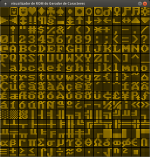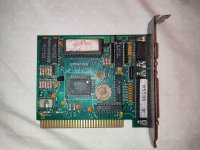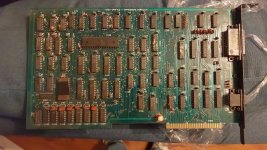Hi folks, good afternoon.
After dealing with some brazilian CGA and EGA video cards, I discovered that most of them supports the Portuguese special characters (Ã and Õ), but the implementation is completely different of any standard. Digging into their character ROMs, I found the ALT codes that produces the characters:
* ALT + 226 = ã
* ALT + 249 = õ
* ALT + 233 = Ã
* ALT + 239 = Õ

That kind of standard seems to be implemented in CGA and EGA cards made by Microtec, CCE, Updating and it's very possible that even more brands adopted it. However, seems that no operating system supported it at all. Microsoft and IBM completely ignored it and 850 was chosen to be the Brazil's codepage, breaking compatibility with everything that came before.
Itautec, in other hand, chose to follow a standard that was already in use abroad. Their CGA cards use a character ROM that follows the 860 codepage, and the DOS clone that was made by them (Sisne Plus) also was CP 860 compliant. Unfortunately, I still don't have a dump of it's character ROM, but I came across a table that an owner of a Itautec CGA card made with it's characters.

The question is: is there a way to make DOS use the previous Brazil standard for Portuguese characters? I know that is possible to hex-edit the DOS messages to use them, but making the keyboard being able to do that is way more complicated and beyond my knowledge.
A few character ROM dumps from brazilian CGA cards:
* CCE MC-5000P Executivo XT: https://datassette.nyc3.cdn.digitalocea ... -5000p.zip
* Microtec CGC II: https://datassette.nyc3.cdn.digitalocea ... i_rev.6.7z
* Microtec CGC 3: https://datassette.nyc3.cdn.digitalocea ... icrotec.7z
* Microtec CGE (EGA BIOS, also follows the standard): https://datassette.nyc3.cdn.digitalocea ... ge_v14.zip
* Updating: https://datassette.nyc3.cdn.digitalocea ... pdating.7z
After dealing with some brazilian CGA and EGA video cards, I discovered that most of them supports the Portuguese special characters (Ã and Õ), but the implementation is completely different of any standard. Digging into their character ROMs, I found the ALT codes that produces the characters:
* ALT + 226 = ã
* ALT + 249 = õ
* ALT + 233 = Ã
* ALT + 239 = Õ

That kind of standard seems to be implemented in CGA and EGA cards made by Microtec, CCE, Updating and it's very possible that even more brands adopted it. However, seems that no operating system supported it at all. Microsoft and IBM completely ignored it and 850 was chosen to be the Brazil's codepage, breaking compatibility with everything that came before.
Itautec, in other hand, chose to follow a standard that was already in use abroad. Their CGA cards use a character ROM that follows the 860 codepage, and the DOS clone that was made by them (Sisne Plus) also was CP 860 compliant. Unfortunately, I still don't have a dump of it's character ROM, but I came across a table that an owner of a Itautec CGA card made with it's characters.

The question is: is there a way to make DOS use the previous Brazil standard for Portuguese characters? I know that is possible to hex-edit the DOS messages to use them, but making the keyboard being able to do that is way more complicated and beyond my knowledge.
A few character ROM dumps from brazilian CGA cards:
* CCE MC-5000P Executivo XT: https://datassette.nyc3.cdn.digitalocea ... -5000p.zip
* Microtec CGC II: https://datassette.nyc3.cdn.digitalocea ... i_rev.6.7z
* Microtec CGC 3: https://datassette.nyc3.cdn.digitalocea ... icrotec.7z
* Microtec CGE (EGA BIOS, also follows the standard): https://datassette.nyc3.cdn.digitalocea ... ge_v14.zip
* Updating: https://datassette.nyc3.cdn.digitalocea ... pdating.7z



